


 |
The La Gruta Hot Springs |
 |
The Atotonilco Folk Art Gallery |
 |
Return to the Index for Our Mexico Trip |
The third stop on our guided tour of San Miguel (after the city overlook and the Folk Art Gallery) was the actual town of Atotonilco and its historic Santuario de Jesús Nazareno de Atotonilco.
|
|
The Sanctuary of Atotonilco is a church complex and part of a World Heritage Site, designated along with San Miguel de Allende. The complex was built in the 18th century by Father Luis Felipe Neri de Alfaro, who, according to tradition, was called upon by a vision of Jesus with a crown of thorns on his head with blood on his face and carrying a cross.
The main feature of the complex is the rich Mexican Baroque mural work that adorns the main nave and chapels. This was chiefly the work of Antonio Martínez de Pocasangre over a period of thirty years. The mural work has led the complex to be dubbed the "Sistine Chapel of Mexico." The complex remains a place of worship and penance to this day, attracting as many as 5,000 visitors every week.
From the gallery we came back out to the Calle Principal and turned north towards Atotonilco. Immediately we passed the old aqueduct that is now the wall of the La Finca event venue:
 |
We continued up the road and very shortly we were coming into Atotonico from the south. Before we actually go inside the church, let's take a look at it from the outside, and get some of the commentary from our tour guide.
|
On the outside the church complex is very plain with high walls that give it a fortress appearance. The outer walls are about ten meters high; the cupolas reach twelve meters and the clock tower is about twenty meters high. The main entrance is also simple under a "mixtilineo" arch that faces east, towards Jerusalem, giving the entire complex an east-west orientation.
To the south along the main facade is the Casa de Ejercicios and the clock tower. To the north is Santa Escuela de Cristo. In front of the main facade is a narrow atrium, which was once used as a cemetery. Today, it is shaded by trees and surrounded by a small fence. The main church is a single nave without a cupola, lined on the north and south flanks by chapels and chambers.
On the north side of the nave, there are the new sacristy, the Rosary Chapel, the chambers of Father Neri, the Belen Chapel/Baptistery and the Reliquary Room. On the south side, there are the Santisimo Chapel, the Soledad Chapel, the Loreto Chapel with its back chamber, the Gloria Escondida Chamber and the Santo Sepulcro Chapel with the Calvario Chapel behind it.
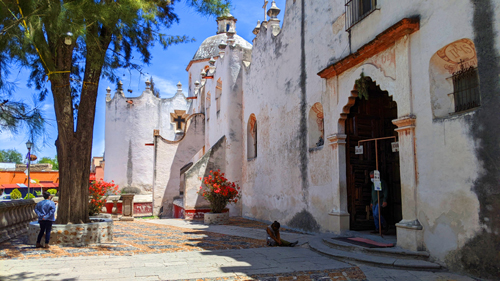 |
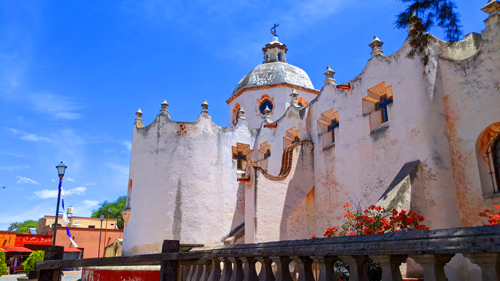 |
Atotonilco is located in an area that is a combination of dry grassland and desert studded with thistles, sweet acacia and mesquite trees. The appearance of the landscape has been compared to that of Jerusalem, which gives believers a connection to the Holy Land. The area also has a large number of thermal and fresh water springs, and a number of spas have been built in the area- including La Gruta that we will visit shortly. When the sanctuary was built, there were 27 fresh water springs to support gardens around the complex. Today, thermal waters still rise up from the ground all around the area.
|
According to tradition, Father Neri arrived here from preaching at missions in Dolores Hidalgo. While resting under a mesquite tree where the sanctuary is now located, he dreamt of Jesus wearing a crown of thorns and carrying a cross. Jesus told Father Neri that it was his will that the area be converted into a place for penance and prayer. A different version of this story states that Father Neri was here due to his ill health and was assisting at a small church called the Capilla de San Miguelito, which is still found on the banks of the Laja River. At that time, the native Guachichiles and Pames were not completely converted to Christianity and considered the thermal springs in the area sacred and medicinal. It was also supposedly a favored place for rites that included fornication. One reason to build the church was to counter this practice.
|
At the end of this phase, it was consecrated and the image of Jesus the Nazarene was placed. The second phase lasted until 1776 when most of the chapels and other annexes were built. As the complex was built, the mural work was done. The main reason behind this was to reinforce the principles of the Council of Trent and the Counter Reformation. Father Neri lived at the construction site until his death in 1776. All that was missing at that time was the Santa Escuela annex, the new sacristy, some hallways and the chaplain’s house, as well as various sculptures, altars and oil paintings. These were added over the next 100 years.
According to the will of Father Neri, the complex cost 22,647 pesos. The main church is dedicated to Jesus of Nazareth. Beginning 88 years after Father Neri’s death, numerous attempts have been made to have the priest beatified, but they have not been successful.
|
if Video Controls Not Visible) |
|
|
Our guide also had some information about the connection between this church and the events of the Mexican War of Independence in the early 19th century, and you can listen to a bit of this explanation in the movie at left, although I'll say more about it when we talk about the two sculptures that are in thie courtyard in front of the church.
Ignacio Allende married Maria de la Luz Agustina de las Fuentes in 1802 in this church. More importantly, the initial banner for the nascent insurgent army depicting the Virgin of Guadalupe was taken from here on 16 September 1810. After the war, the community became part of the municipality of San Miguel de Allende.
Since that time the art and architecture of the Sanctuary suffered from deterioration, mostly due to high humidity. This humidity comes from the thermal springs that flow under the ground on which the complex rests, and which also have a high mineral content. The moisture and minerals were seeping into the walls and foundations, causing them to crumble and were causing damage to the murals, oil paintings and sculptures.
Restoration work began in 1994, starting with the chapels. To highlight this effort the site was listed in the 1996 World Monuments Watch by the World Monuments Fund. About half of the oil paintings and all of the mural work were saved. Funds for the work came from various sources, including the state and federal governments, the World Monuments Fund and private sources such as American Express. After repairing water damage in the walls and roofs, sealant was applied. Further restoration work was undertaken in 2010 as part of the preparations for Mexico’s Bicentennial. The walls and roofs were aired out and old wells were cleaned out to allow drainage away from the foundation. Channels were constructed in the foundation for the same purpose.The remains of the Sagrado Corazon Chapel were demolished. It was not part of the original construction and had blocked light into a portion of the complex. The arch to the La Higuera courtyard was uncovered. However, the tree planted in this courtyard remains as it was planted in memory of the sanctuary’s founder. This courtyard was reconstructed as it is an important part in providing light and drainage to keep the complex dry.
|
A professor at the Colegio de San Nicolás Obispo in Valladolid, Hidalgo was influenced by Enlightenment ideas, which contributed to his ouster in 1792. He served in a church in Colima and then in Dolores. After his arrival, he was shocked by the rich soil he had found. He tried to help the poor by showing them how to grow olives and grapes, but in New Spain (modern Mexico) growing these crops was discouraged or prohibited by colonial authorities to prevent competition with imports from Spain. On 16 September 1810 he gave the Cry of Dolores, a speech calling upon the people to protect the interest of their King Ferdinand VII, held captive during the Peninsular War, by revolting against the European-born Spaniards who had overthrown the Spanish Viceroy José de Iturrigaray.
He marched across Mexico and gathered an army of nearly 90,000 poor farmers and Mexican civilians who attacked Spanish Peninsular and Criollo elites. Hidalgo's troops lacked training and were poorly armed. These troops ran into an army of well-trained and armed Spanish troops in the Battle of Calderón Bridge and were defeated. After the battle, Hidalgo and his remaining troops fled north, but Hidalgo was betrayed, captured and executed.
Miguel Hidalgo y Costilla was a church father, the father of three children, and the father of his country (even though it was Agustín de Iturbide and not Hidalgo who became the first head of state of Mexico in 1821. Shortly after gaining independence, the day to celebrate it varied between 16 September, the day of Hidalgo's Cry of Dolores, and 27 September, when Iturbide's forces captured Mexico City, ending the war. Later, political movements would favor the more liberal Hidalgo, and 16 September 1810 became officially recognized as the day of Mexican independence, as Hidalgo is considered to be precursor and creator of the rest of the heroes of the Mexican War of Independence.
|
The town of his parish was renamed Dolores Hidalgo in his honor and the state of Hidalgo was created in 1869. Every year on the night of 15–16 September, the president of Mexico re-enacts the Cry of Dolores from the balcony of the National Palace, and this scene is repeated by the heads of cities and towns all over Mexico.
Hidalgo's remains lie in the column of the Angel of Independence in Mexico City. Next to it is a lamp lit to represent the sacrifice of those who gave their lives for Mexican Independence. On the occasion of the bicentennial of Mexican Independence, a stela representing liberty was placed beside the statue of Hidalgo.
We now had time to go into the sanctuary and have a look around. The walls and ceilings of the interior are nearly entirely covered in mural work, sculpture, inscriptions and oil paintings in a style called Mexican folk Baroque, although indigenous influence can be seen.
|
(Mouseover Image if Video Controls Not Visible) |
The story of Jesus from the Gospels is told along the main nave of the church, especially along the ceiling. At the entrance area, there are images related to the Last Judgment. In the highest part, Jesus appears crowned and with a cape carrying a cross, and blessing certain chosen people with his right hand. On the left side are the "damned", tied up, with their faces showing their agony.
As we move along the nave towards the main altar, the ceiling is divided into sections by arches. These arches contain verses written by Father Neri which relate to the scene painted on each vault. These scenes include Jesus giving a blessing to Mary; Jesus praying in Gethsemane and receiving comfort from an angel; Judas Iscariot with a devil on his back, betraying Jesus with a kiss; Jesus replacing Malhus' ear after Peter attacks him; and the Baptism of Jesus in the Jordan River, accompanied by John the Baptist.
Another scene has Jesus in the house of Caiaphas. Seventy two judges try Jesus with Pontius Pilate on the side in the balcony. On the north side, Pilate appears again but the Jewish judges stay outside the Roman magistrate's house because they are observing Passover. The south side presents Pilate presenting Jesus and Barabbas and asking to choose whom to release. On the east side is a scene with Jesus being flogged while tied to a post. On the south wall, there is a Neoclassical altarpiece of stone with gold leaf. This contains an image of Christ tied to a post and bearing the marks of being flogged. This is called the Señor de la Columna.
|
The main altarpiece was made between 1812 and 1820. It contains the image of Jesus of Nazareth, which was placed there by Father Neri in 1748. This sculpture is made of wood and dressed with a cloth tunic. The face is typical for this kind of image of the 18th century and comes from Seville, Spain.
On the north side of the nave, there are two chapels with mural work and other decorations. The Bethlehem Chapel is dedicated to the birth of Jesus. It was constructed between 1759 and 1763, but the altar is a Neoclassic design dating from the 19th century. It contains medallions painted in oils. The vault contains a conjunction of angels that sing the arrival of the Messiah, peace, and a group of shepherds who come to adore the child. Both the angels and the shepherds hold up signs with the Apostles' Creed. There is also a scene with the Holy Trinity that accompanies the Virgin Mary who is crowned. On the left, idols fall before the birth of Christ.
|
The Rosary Chapel was constructed in 1763 and its vault is divided into four triangular segments. The north segment contains a naval battle where galleons, with Spanish and Ottoman coats of arms, fire at each other, referring to the Battle of Lepanto. The Virgin of the Rosary is credited with the Spanish victory. On the south side, there is a ceremony dedicated to the Virgin Mary in Rome, presided over by Pope Pius V. The main altar is gilded and contains the image of the Virgin. There are 15 small sections over mirrors with scenes related to the mysteries of the Rosary. On the east and west walls there are images of saints grouped by monastic order. In the interior of the chamber, there are portraits of Father Neri, Esteban Valerio de Alfaro and María Velázquez de Casillta (his parents). By the windows are portraits of Doctor Díaz de Gamarra and Dominican friar Francisco Alonso de Rivera and a self portrait of Pocasangre, who emphasizes his indigenous features. The roof of this inner chamber is in the form of a large shell. Writings such as the Ave Maria, prayers, saints' names and more are inscribed on the ribs of the shell.
|
The inside of the chapel was almost overly-decorated; there was perhaps more iconography and wall decoration than I have seen before in a chapel of its size, and we took quite a few pictures- so many that the only feasible way to show them to you is in a slideshow.
To view the slideshow, just click on the image at right and I will open the slideshow in a new window. In the slideshow, you can use the little arrows in the lower corners of each image to move from one to the next, and the index numbers in the upper left of each image will tell you where you are in the series. When you are finished looking at the pictures, just close the popup window.
I thought that the inside of the sanctuary was pretty amazing; it would have required lots more time than we had to see everything and understand the significance of it all. But I wanted to see a bit of this small town before we had to head off, so we went back outside.
 |
From the front of the church, we began walking up the street to the north. It was lined with small stalls selling all manner of trinkets. At the foot of the street, one vendor had her dog with her, and it was sleeping soundly in the shade. I suppose it really didn't deserve a picture, but I thought the breed of the dog was appropriate to where we were. There really wasn't much reason take pictures of what was obviously just locals selling souvenirs, but I did take a few anyway:
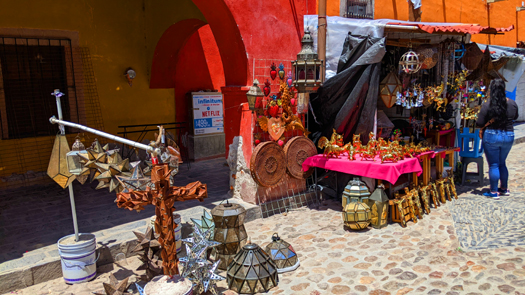 |
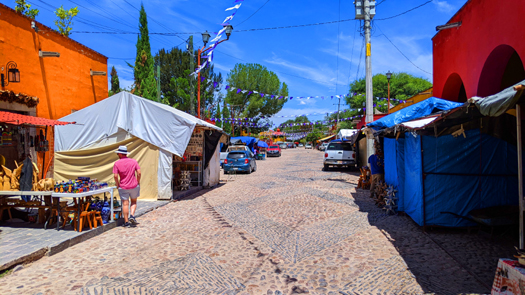 |
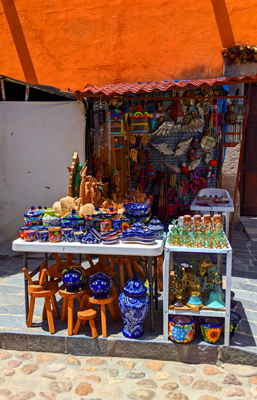 |
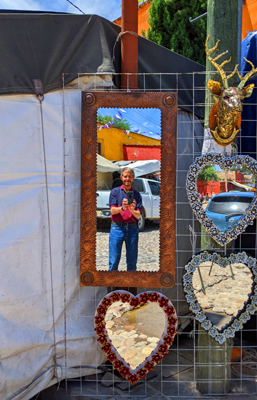
| 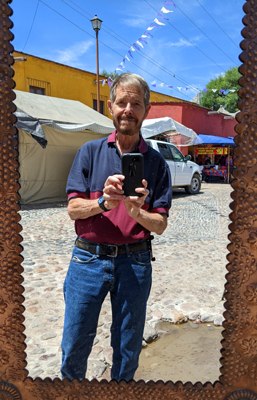 |
The short drive up here to Atotonilco and the Santuario de Jesús Nazareno de Atotonilco was certainly worthwhile. The historic church was quite beautiful, inside and out, and the little town was charming. We had one more stop to make on today's guided tour, so we piled into the SUV and headed off south.
You can use the links below to continue to another photo album page.
 |
The La Gruta Hot Springs |
 |
The Atotonilco Folk Art Gallery |
 |
Return to the Index for Our Mexico Trip |